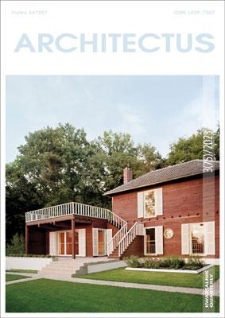Dolnośląska Biblioteka Cyfrowa udostępnia 109 394 obiektów cyfrowych
Obiekt
Tytuł: Transformations of the form and façade of the Lehndorff palace in Sztynort Duży in the light of architectural research
Tytuł odmienny:
Autor:
Współtwórca:
Opis:
Architectus : Pismo Wydziału Architektury Politechniki Wrocławskiej, 2023, nr 3 (75), s. 15-25
Abstrakt:
Wydawca:
Oficyna Wydawnicza Politechniki Wrocławskiej
Miejsce wydania:
Data wydania:
Typ zasobu:
Identyfikator zasobu:
doi:10.37190/arc230302 ; oai:dbc.wroc.pl:126248
Źródło:
<sygn. PWr A5234III> ; kliknij tutaj, żeby przejść ; www.architectus.arch.pwr.wroc.pl ; kliknij tutaj, żeby przejść
Język:
Powiązania:
Architectus : Pismo Wydziału Architektury Politechniki Wrocławskiej ; Architectus : Pismo Wydziału Architektury Politechniki Wrocławskiej, 2023 ; Architectus : Pismo Wydziału Architektury Politechniki Wrocławskiej, 2023, nr 3 (75)
Prawa:
Pewne prawa zastrzeżone na rzecz Autorów i Wydawcy
Prawa dostępu:
Dla wszystkich zgodnie z licencją
Licencja:
CC BY-NC-ND
Lokalizacja oryginału:
Tytuł publikacji grupowej:
Kolekcje, do których przypisany jest obiekt:
- Dolnośląska Biblioteka Cyfrowa > Uczestnicy Konsorcjum > 01. Politechnika Wrocławska > Czasopisma > Wydane w PWr > Architectus
- Dolnośląska Biblioteka Cyfrowa > Zasoby > 2. Czasopisma > Czasopisma współczesne
- Dolnośląska Biblioteka Cyfrowa > Dziedziny nauki > 2. Nauki inżynieryjno-techniczne
Data ostatniej modyfikacji:
11 kwi 2024
Data dodania obiektu:
11 kwi 2024
Liczba wyświetleń treści obiektu:
143
Wszystkie dostępne wersje tego obiektu:
https://www.dbc.wroc.pl/publication/165110
Wyświetl opis w formacie RDF:
Wyświetl opis w formacie OAI-PMH:
| Nazwa wydania | Data |
|---|---|
| Transformations of the form and façade of the Lehndorff palace in Sztynort Duży in the light of architectural research | 11 kwi 2024 |
Obiekty Podobne
Piaskowska, Beata Prarat, Maciej Różański, Artur Olszacki, Tomasz Schaaf, Ulrich Łużyniecka, Ewa. Redakcja
Schaaf, Ulrich Prarat, Maciej Ważny, Tomasz Łużyniecka, Ewa. Redakcja
Instytut Historii Architektury Sztuki i Techniki Politechniki Wrocławskiej
Instytut Historii Architektury Sztuki i Techniki Politechniki Wrocławskiej
Instytut Historii Architektury Sztuki i Techniki Politechniki Wrocławskiej
Instytut Historii Architektury Sztuki i Techniki Politechniki Wrocławskiej
Kucharzewska, Joanna Łużyniecka, Ewa. Redakcja
Instytut Historii Architektury Sztuki i Techniki Politechniki Wrocławskiej
























